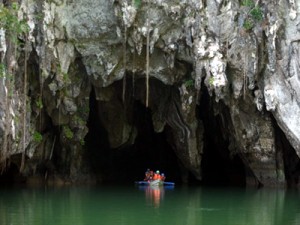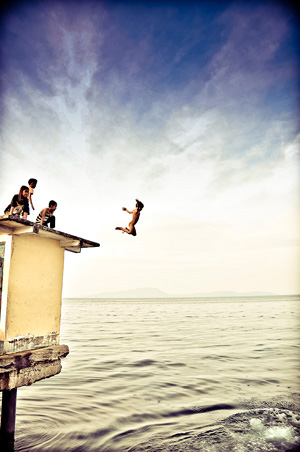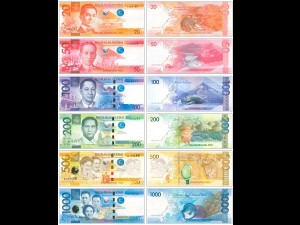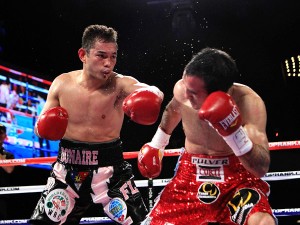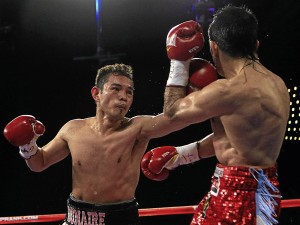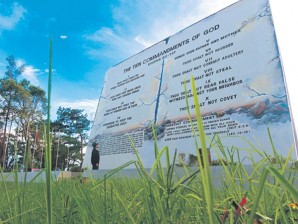
WORLD’S FIRST This 12-meter-high building shaped like the Ten Commandments tablets in Baguio City’s Dominican Hill earned a Guinness World Record. RICHARD BALONGLONG/INQUIRER NORTHERN LUZON
BAGUIO CITY—A 12.19-meter-high building painted like stone tablets containing the biblical Ten Commandments has earned for the summer capital a Guinness World Record, thanks to a businesswoman who also funded the unveiling of a giant Philippine flag here earlier this year.
Grace Galindez-Gupana seems to have a penchant for setting world records. Her company claims she now holds seven records, including being the creator of the biggest national flag and organizer of the biggest clinical sessions for diabetics and cholesterol watchers.
Gupana, chief executive officer of ABS Gen Herbs International Corp., turned over to the city government a P5.5-million, A-shaped “prayer building” featuring the Ten Commandments in July.
Gupana commissioned Nueva Ecija contractors in March to design and rush work on the structure located within the Diplomat Hotel compound, said Rafael Talokoy, executive secretary of Baguio Mayor Mauricio Domogan.
The fully furnished building has inclined 12-meter (40-foot) walls. One wall bears inscriptions of the Ten Commandments, portraying the two slabs of stone that were borne by Moses as described in the Bible.
Domogan on Friday said his office had confirmed the Guinness citation and that a representative from the organization would be coming here this week with the official document. “We were assured that the building is a world-record holder,” he said.
The mayor recalled that Gupana, who he said “considers Baguio the Philippine city of worship,” offered to build the facility in February. This was after she led the unveiling of a giant Philippine flag for a second time at the Baguio Athletic Bowl.
“After turning over the building, Gupana went on her own to apply and earn a certification from the Guinness organization that this is the world’s first and tallest facility (that features the) Ten Commandments,” Talokoy said.
Other records
According to ABS Gen’s website, Gupana holds seven Guinness World Records, among them the feat of developing the world’s largest national flag, an 18,847-square meter Israeli banner which can cover an area of two football fields.
The site claimed that Gupana earned world record citations for producing the longest banner (composed of giant flags representing the Philippines, Israel and the two Koreas), the longest drawing of the Biblical serpent, dragon and beast mentioned in the Book of Revelations (5 kilometers long and 7 m wide), and the largest blood pressure checkup session that gathered 2,302 people.
The site also credited Gupana for organizing the largest diabetes screening session for 503 people, the largest blood identification session involving 260 people, and the largest cholesterol test session for 527 people.
The Inquirer could not independently confirm the authenticity of the world records.
The Ten Commandments building will be officially unveiled on Oct. 26 in the presence of Israeli Ambassador to the Philippines Menashe Bar-On and the Guinness representative.
Domogan said the building would remain open to the public until the city council decides how the local government can regulate its use, Domogan said.
3-way land dispute
The location of Gupana’s facility earlier figured in a property dispute, after the 17-hectare Diplomat Hotel compound was relinquished to the city by the national government during the Arroyo administration in April 2004.
The property became the subject of a three-way tug-of-war. The Sandiganbayan antigraft court maintained that it was promised a portion of the compound for its summer courthouse, the city’s evangelical community wanted the facility turned into a “prayer mountain,” while another group planned to convert the old hotel into a mining museum.
Domogan said he was called to Malacañang recently because the Presidential Management Staff (PMS) wanted an explanation as to why Gupana’s building was built there although there was still conflict over the compound’s use.
The conflict arose from a proposal made to the city council by former Foreign Secretary Delia Albert and civic leader Maria Isabel Ongpin to convert Diplomat Hotel into an interactive mining museum and library.
The plan would exclude from the project a prayer facility being proposed by former Councilor Galo Weygan, an evangelical pastor. Weygan, who had been holding monthly religious assemblies in the compound, opposed the museum project.
Palace wants it back
Former Mayor Reinaldo Bautista Jr. said the PMS sent a deed of reconveyance to the city in 2008, indicating that Malacañang intended to take back the Diplomat compound because the city government had reneged on its obligation to develop it in five years.
“Malacañang was ready to take it back because it was convinced by officials backing the mining museum project that it would be better for them to transact with the Palace instead of the city government. But at the end of her term last year, Arroyo urged all parties to present their case before the new set of officials instead,” said Domogan, who was Baguio’s representative at the time.
Cordelia Lacsamana, a city environment officer who oversees the compound, noted that the Sandiganbayan had started building its summer compound on portions of the property.
Domogan said the city government had urged Albert to present her group’s plans again to the city council “so we can finally develop that property.”
But last week, proponents of the mining museum reportedly agreed to an alternative proposal to secure one of the three sequestered Baguio properties of the late dictator Ferdinand Marcos as their project site, Domogan said.
“I endorsed that proposal also,” he said. “This means that the government can offer the Diplomat Hotel as a Public-Private Partnership project. We need to develop a hotel there because the [Ten Commandments building] will start drawing tourists soon.”


